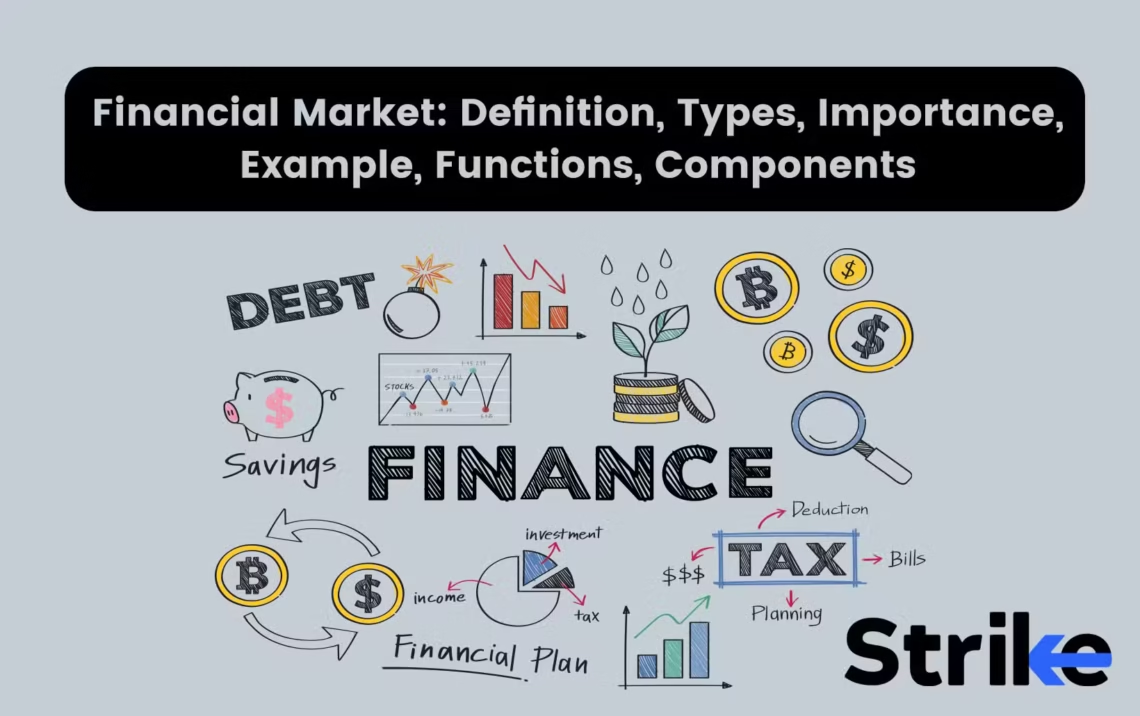When I was a broke college grad, I thought the financial market was some mysterious Wall Street beast, full of suits shouting numbers I’d never understand. Then, a mentor introduced me to a money market fund, and suddenly, I was part of this vast ecosystem, earning modest interest on my savings without breaking a sweat. That’s the financial market for you – a bustling hub where money moves, dreams are funded, and economies thrive. In this guide, we’ll unravel what financial markets are, their types, why they matter, real-world examples, their functions, and the key components that keep them ticking. As of August 2025, with markets navigating post-inflation stability, this exploration will give you the tools to dive in confidently, whether you’re saving for a car or eyeing global investments.
What Is a Financial Market?
A financial market is a platform where buyers and sellers trade financial assets like stocks, bonds, currencies, and derivatives. It’s where capital flows from those with extra funds to those needing it, from governments to startups. Think of it as the economy’s bloodstream, circulating money to fuel growth and stability.
These markets operate globally, with daily volumes in trillions, driven by supply, demand, and economic signals. They’re essential for wealth creation and resource allocation.
Defining Financial Markets Simply
Imagine a giant marketplace where people swap money for promises – stocks for ownership, bonds for interest, or currencies for trade. It’s not just Wall Street; it includes banks, online brokers, and even crypto exchanges. Accessibility has surged with digital platforms in 2025.
My first foray was a tiny stock purchase via an app – nerve-wracking but empowering.
Key Characteristics of Financial Markets
They’re marked by transparency, with prices reflecting real-time data. Liquidity ensures quick trades, while regulation, like SEC oversight, maintains fairness. Volatility varies by market type, from stable bonds to wild crypto.
In 2025, tech-driven platforms make participation easier, but risks remain.
Types of Financial Markets
Financial markets come in various flavors, each serving unique purposes. From stocks fueling corporate growth to forex enabling global trade, understanding types helps you navigate investment options.
In 2025, diverse markets cater to both risk-takers and cautious savers.
Stock Market
This is where company shares trade, like the NYSE or Nasdaq. Investors buy ownership stakes, hoping for price gains or dividends. It’s volatile but offers growth potential.
I once bought a tech stock that soared – felt like hitting a small jackpot!
Bond Market
Here, debt securities like government or corporate bonds are traded. Investors lend money, earning interest over time. It’s safer than stocks, with steady returns.
Great for those, like me, who prefer predictable income over rollercoasters.
Money Market
Focused on short-term debt (under a year), like T-bills or CDs. It prioritizes liquidity and low risk, ideal for parking cash. Yields in 2025 hit 4-5%.
Perfect for emergency funds, as I learned during a budget crunch.
Derivatives Market
This trades contracts like futures or options, tied to assets like stocks or commodities. Used for hedging or speculation, it’s complex and risky.
Big players use it to manage risks, but it’s not my cup of tea.
Foreign Exchange (Forex) Market
The largest market globally, forex trades currencies, like USD to EUR. It’s crucial for international trade and travel, with $7.5 trillion daily volume in 2025.
I swapped dollars for euros for a trip – forex made it seamless.
Commodities Market
This deals in physical goods like oil, gold, or wheat. Futures contracts dominate, used by producers and investors. Prices can swing wildly.
Gold investments helped me hedge inflation fears last year.
Cryptocurrency Market
A newer player, trading digital assets like Bitcoin or Ethereum. Decentralized and volatile, it’s grown mainstream by 2025, with regulated exchanges emerging.
I dabbled in crypto – thrilling, but my heart raced with every dip.
Importance of Financial Markets
These markets are the economy’s backbone, channeling funds to where they’re needed most. They enable businesses to grow, governments to function, and individuals to build wealth.
In 2025, they’re key in stabilizing economies post-rate hikes.
- Facilitate capital raising for businesses.
- Provide investment opportunities for wealth growth.
- Enhance liquidity for quick asset conversion.
- Support global trade via currency exchange.
- Influence monetary policy through rates.
Economic Growth and Capital Allocation
Companies issue stocks or bonds to fund expansion, creating jobs. Investors fuel this by allocating savings to promising ventures.
Think Apple’s IPO in 1980 – it sparked tech revolutions.
Wealth Creation and Investment Opportunities
Markets let individuals grow savings through diverse assets. From stocks to crypto, there’s something for every risk appetite.
My small stock gains funded a dream vacation – markets made it real.
Price Discovery and Market Efficiency
Markets set asset prices via supply and demand, reflecting true value. This transparency guides investment decisions.
In 2025, real-time data apps make this process instant.
Example of a Financial Market in Action
Consider the stock market during Tesla’s 2020 surge. Investors poured in, driving shares from $100 to over $400 (split-adjusted) as EV hype grew. The market facilitated capital flow to Tesla, funding its expansion.
This shows how markets connect investor optimism to corporate growth.
Real-World Case: U.S. Treasury Market
In 2025, T-bills in the money market see heavy trading as investors seek safety amid volatility. Auctions via TreasuryDirect move billions weekly, offering 4.3% yields.
It’s a safe bet, like my emergency fund choice.
Global Example: Forex Market Dynamics
When the USD strengthens, exporters in Japan sell yen for dollars to balance trade. The forex market handles this, with $7.5 trillion daily trades ensuring liquidity.
This keeps global commerce humming smoothly.
Functions of Financial Markets
Markets do more than trade – they’re economic engines. They provide liquidity, set prices, and reduce transaction costs. They also manage risks through derivatives.
In 2025, they’re vital for navigating inflation and geopolitical shifts.
Liquidity Provision
Markets let you sell assets quickly without price loss. This ensures cash flow for businesses and investors alike.
My quick stock sale for a car down payment proved this.
Price Determination
Supply and demand set fair prices, guiding resource allocation. Transparent pricing builds trust and efficiency.
Apps now show real-time quotes, empowering decisions.
Risk Management
Derivatives like options hedge against price swings. This protects farmers, firms, and investors from uncertainty.
Hedging oil prices helps airlines plan better, for instance.
Capital Mobilization
Markets channel savings to productive uses, like funding startups or infrastructure. This drives economic progress.
Think of crowdfunding platforms scaling up via markets.
Components of Financial Markets
Key elements include instruments, participants, institutions, and regulations. Each plays a role in keeping markets functional and fair.
Together, they create a dynamic ecosystem for wealth and growth.
Financial Instruments
These are assets traded, like stocks, bonds, or futures. Each serves specific needs, from growth to safety.
I diversified with bonds and stocks for balance.
Participants
Include individual investors, institutions like pension funds, and governments. They drive market activity with varied goals.
Retail investors like me now trade via apps easily.
Financial Institutions
Banks, brokers, and exchanges facilitate trades. Firms like Goldman Sachs or Nasdaq ensure smooth operations.
Online brokers in 2025 make entry seamless for newbies.
Regulators
Bodies like the SEC or CFTC enforce rules, ensuring transparency and fairness. They protect against fraud and manipulation.
Post-2008 reforms tightened oversight, boosting trust.
Comparing Financial Markets
Each market serves distinct needs, balancing risk and reward. Here’s how they stack up.
| Market | Purpose | Risk Level | Key Instruments | Example Platform |
|---|---|---|---|---|
| Stock | Ownership, growth | High | Shares | NYSE, Nasdaq |
| Bond | Debt, income | Moderate | Bonds, notes | OTC markets |
| Money | Liquidity, safety | Low | T-bills, CDs | TreasuryDirect |
| Forex | Currency exchange | High | Currencies | Forex.com |
| Crypto | Digital assets | Very high | Bitcoin, Ethereum | Coinbase |
This table clarifies their roles and risks.
Pros and Cons of Stock vs. Money Markets
Pros of Stocks: High growth potential; dividends; ownership stake.
Cons: Volatility; no guarantees; requires research.
Pros of Money Markets: Safety; liquidity; stable returns.
Cons: Low yields; inflation risk; limited growth.
Pros and Cons of Investing in Financial Markets
Pros: Wealth-building; diversification; economic participation.
Cons: Risk of loss; complexity; fees and taxes.
People Also Ask
From Google searches, here are real questions about financial markets with clear answers.
What is a financial market in simple terms?
It’s a place where people trade assets like stocks, bonds, or currencies to raise or invest money.
What are the main types of financial markets?
Stock, bond, money, derivatives, forex, commodities, and crypto markets, each with unique assets.
Why are financial markets important?
They fund businesses, create wealth, and ensure liquidity, driving economic growth and stability.
What is an example of a financial market?
The NYSE, where stocks like Apple trade daily, connecting investors and companies.
How to Participate in Financial Markets
Start with a brokerage account via platforms like Fidelity or Robinhood. Research assets matching your goals – stocks for growth, bonds for safety. In 2025, low-fee apps make entry easy.
Compare platforms for fees and tools before investing.
Where to Access Financial Markets
Online brokers like Schwab or E*TRADE offer stocks and funds. TreasuryDirect handles T-bills. Crypto exchanges like Binance cover digital assets.
Banks also provide money market accounts for beginners.
Best Tools for Tracking Market Performance
Use Yahoo Finance for real-time quotes; Morningstar for fund analysis. Apps like TradingView offer charting.
I track my portfolio with Google Sheets – simple yet effective.
The Future of Financial Markets in 2025
With AI-driven trading and ESG-focused investments rising, markets are evolving. Crypto regulation is tightening, boosting trust. Global markets remain interconnected, navigating geopolitical shifts.
Sustainability and tech will shape the next decade.
FAQ
What is the main function of financial markets?
To facilitate trading of assets, ensuring liquidity, price discovery, and capital flow.
How do financial markets benefit investors?
They offer opportunities for wealth growth, diversification, and income through various assets.
What are the risks of financial markets?
Losses from volatility, fees, and economic shifts; crypto and derivatives carry higher risks.
Where can I find reliable market data?
Sites like Bloomberg, Yahoo Finance, or Morningstar provide real-time insights.
Why are regulations important in financial markets?
They ensure fairness, transparency, and investor protection, preventing fraud and crashes.




